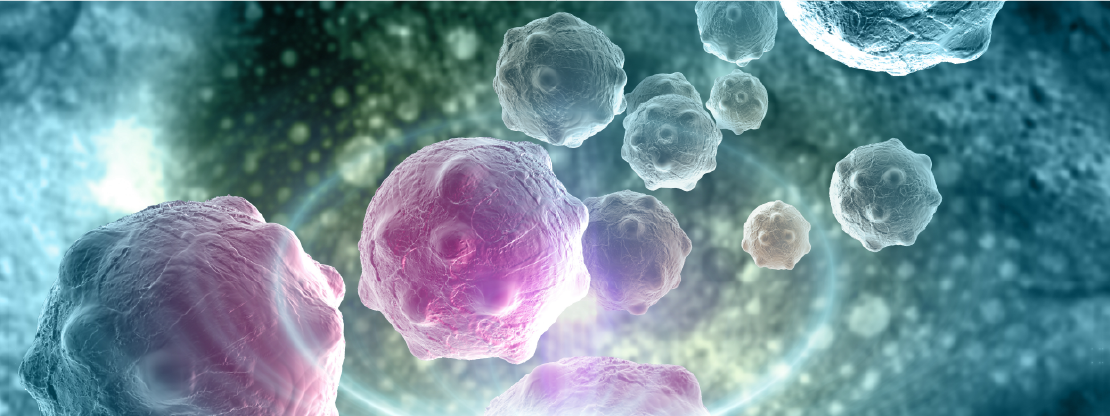What is cancer, and how can research help?
November 22, 2021

What is cancer?
Cancer is a blanket term for more than 100 related diseases that have a core characteristic in common — unchecked cell growth.
At the most basic level, cancers occur when cells divide out of control, eventually interfering with important processes that keep us healthy. Cancer cells also may spread to other tissues, a process called metastasis.
Cancer cells have an arsenal of tools to help them spread. They can hide from the immune cells that comprise the body’s defense system. They can cause the other cells around the tumor, called the tumor microenvironment, to reroute resources to supply the tumor with needed nutrients. And, unlike healthy cells, malignant cells can divide endlessly.
What causes cancer?
Our bodies are made up of an estimated 37.2 trillion cells, each of which has a particular job and usually operates on a set life cycle. Normally when a cell grows old or becomes damaged, it dies, which makes room for new cells. In cancer, old or abnormal cells survive and continue to divide. In many cancers, they may then form masses of tissue called tumors. In blood cancers, such as leukemia, lymphoma and myeloma, cancer cells are found in the blood, bone marrow, lymphatic system and plasma, respectively.
But what goes wrong? How does a normal cell become a cancer cell?
The answer lies in the instructions that make us human — our genetic code. Ultimately, cancer is the result of errors in these instructions (our genetics) or in the way they are read and acted upon (our epigenetics). There are many ways that this can occur, including:
- DNA replication mistakes: During the normal cell division process, our genetic code is copied and passed on to new cells. Occasionally, mistakes occur, and the code is copied incorrectly. These errors are usually fixed by a cell’s quality control process, but sometimes errors slip through the cracks. Cancer can arise when these errors occur on certain genes, such as those that tell cells when to stop dividing.
- Epigenetic errors: Every cell in the body has the same set of genetic instructions but not all these instructions are needed at any given time or by every single cell. That’s where epigenetics comes in. Epigenetics refers to the processes by which the instructions in DNA are selected and acted upon — akin to reading a single recipe in a cookbook while ignoring the others. Epigenetic errors are present in essentially all cancers; for example, epigenetic errors can switch off a cell’s ability to die when it is damaged, allowing it to grow uncontrollably.
- Genetic inheritance: Some genetic mutations that increase cancer risk may be passed down from generation to generation. An example is mutations to the BRCA1 and BRCA2 genes, which increase the risk of developing breast and ovarian cancers.
- External factors: Many things can cause DNA mutations that may eventually give rise to cancer. Examples include sunlight (skin cancers); viruses, such as certain strains of human papillomavirus (cervical cancer), and bacteria such as Helicobacter pylori (stomach cancer); substances such as asbestos (mesothelioma); and lifestyle choices, such as smoking cigarettes (lung, throat and oral cancers).
How does research impact cancer treatment?
Understanding how cancer works on a basic level allows scientists to develop new ways to treat it more precisely. Here are some examples of areas that are at the forefront of cancer research.
- Epigenetic therapy: Sometimes it’s not a change in the genetic code that causes a problem, but rather an error in the way the code is read. Drugs that target these epigenetic errors — errors literally “on top of” the genome — have been shown to “prime” cancer cells, making them more receptive to other therapies. Van Andel Institute is a global hub for this growing area of research, which holds great promise for finding new ways to treat cancer. Read more about VAI’s epigenetics research here.
- Immunotherapy: Immunotherapies harness the robust strength of the body’s natural defenses to fight cancer. These groundbreaking treatments also may be used in combination with other cancer treatments to bolster their effect. For example, the Van Andel Institute–Stand Up To Cancer Epigenetics Dream Team is investigating whether combining immunotherapy medications with epigenetic drugs may improve treatment of non-small cell lung cancer, bladder cancer, myelodysplastic syndrome, and liver, pancreatic and gallbladder cancers. Read more about the VAI–SU2C Epigenetics Dream Team here.
- Earlier detection: Some cancers, such as pancreatic cancer, are incredibly difficult to detect early, which complicates treatment and can lead to poorer outcomes. VAI scientists are hard at work to find simpler, more effective ways to diagnose these tough-to-catch cancers early and to help sort out which cancers will respond to treatment from those that are resistant to treatment. Read more here.
- Personalized medicine: No two people are the same, and no two cancers are the same. Using cutting-edge techniques to understand an individual’s specific disease helps physicians to tailor treatments that better fit the patient.

